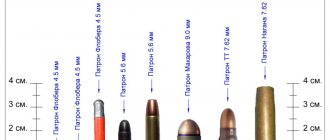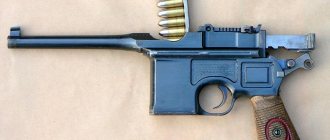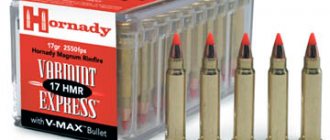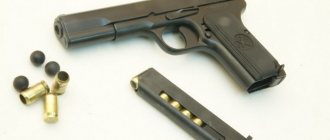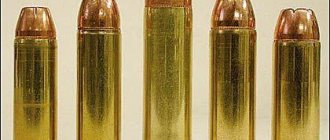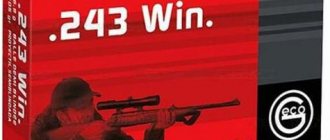In Russia, the development of a pistol cartridge with a subsonic bullet speed of 9x19 mm caliber has begun. It is being created by specialists from the Central Research Institute of Precision Engineering (TsNIITochmash), the Rostec press service said in a statement.
What kind of “Boa Constrictor” pistol will be used by the Ministry of Defense? More details
Subsonic cartridges 366 tkm recipe
In this review we use: Lee reloading press, Dies for .366 Bullets: standard SP13.
Capsule: TulAmmo KVB-7 magnum Cases: Reduced volume of powder chamber for loading subsonic cartridges https://forum.guns.ru/forummessage/329/2343893-0.html Gunpowder: “Sunar 7.62” And special thanks to Igor Igorevich for “Gyurza” bar on SKS, the bar is SUPER! Result: 12 shots were fired (4 series of 3 shots each)
I'm interested in your opinion on the result. Is it worth developing the topic further? I will be glad to criticize, suggestions and reviews from other people on the topic of subsonic. PS: If the topic is interesting, I’ll shoot at 100 m in normal conditions, with normal targets at the shooting range)
Not the best option for this. For subsonic sound you need fast gunpowder. The Banal Falcon is one of the best and most affordable options for this.
It unwinds a heavy bullet at 300 mys, already 50 meters away, the irons and flights “in that direction” begin, it does not assemble into an A4 sheet. Lancaster with a pitch of 500 mm is necessary at a minimum for at least some ballistics of such a cartridge, and with today’s paradox it’s only pornography.
Moreover, somewhere around 32-35 grams of gunpowder burns cleanly, starting from Magnum and further to Sokol/410, soot and clogging of muzzle devices begins. At least on VPO-209.
The position of the powder in the cartridge case at the moment of firing affects the initial velocity. Today I experimented myself. Once, even a bullet got stuck in the barrel when, before firing, I tilted the barrel forward and shook it so that the gunpowder would fall towards the bullet. Instead of a shot, I received such a “pffffpock”. And when he broke the gun, the cartridge case was squeezed out by powder gases with a characteristic “puff!” I knocked out the bullet with the next cartridge case without a bullet, just took the bullet out and fired.
When equipping a half load with native powder, there is a lot of free space left in the FMJ case. How to fill it? Do not offer synthetic polystyrene and polystyrene foam, this is an extreme case - because it costs DTK (otherwise, what’s the point of shooting subsonic if you don’t use DTK). So I’m thinking of compensating for the “shortage” of gunpowder with sawdust or semolina?
Has anyone tried black powder? I read about a weight of 1.6-1.7 grams for a 16gr bullet. Has anyone tried it?
I don't want to use special sleeves. Now I just spray the factory cartridge with a hammer and remove the “extra” gunpowder. And I return the bullet to its place with a rubber mallet.
The position of the powder in the cartridge case at the moment of firing affects the initial velocity. Today I experimented myself. Once, even a bullet got stuck in the barrel when, before firing, I tilted the barrel forward and shook it so that the gunpowder would fall towards the bullet. Instead of a shot, I received such a “pffffpock”. And when he broke the gun, the cartridge case was squeezed out by powder gases with a characteristic “puff!” I knocked out the bullet with the next cartridge case without a bullet, just took the bullet out and fired.
When equipping a half load with native powder, there is a lot of free space left in the FMJ case. How to fill it? Do not offer synthetic polystyrene and polystyrene foam, this is an extreme case - because it costs DTK (otherwise, what’s the point of shooting subsonic if you don’t use DTK). So I’m thinking of compensating for the “shortage” of gunpowder with sawdust or semolina?
Has anyone tried black powder? I read about a weight of 1.6-1.7 grams for a 16gr bullet. Has anyone tried it?
I don't want to use special sleeves. Now I just spray the factory cartridge with a hammer and remove the “extra” gunpowder. And I return the bullet to its place with a rubber mallet.
The position of the powder in the cartridge case at the moment of firing affects the initial velocity. Today I experimented myself. Once, even a bullet got stuck in the barrel when, before firing, I tilted the barrel forward and shook it so that the gunpowder would fall towards the bullet. Instead of a shot, I received such a “pffffpock”. And when he broke the gun, the cartridge case was squeezed out by powder gases with a characteristic “puff!” I knocked out the bullet with the next cartridge case without a bullet, just took the bullet out and fired.
When equipping a half load with native powder, there is a lot of free space left in the FMJ case. How to fill it? Do not offer synthetic polystyrene and polystyrene foam, this is an extreme case - because it costs DTK (otherwise, what’s the point of shooting subsonic if you don’t use DTK). So I’m thinking of compensating for the “shortage” of gunpowder with sawdust or semolina?
Has anyone tried black powder? I read about a weight of 1.6-1.7 grams for a 16gr bullet. Has anyone tried it?
I don't want to use special sleeves. Now I just spray the factory cartridge with a hammer and remove the “extra” gunpowder. And I return the bullet to its place with a rubber mallet.
I’ll share my subsonic experience.
1. Conducted an experiment with 0.6 grams of sunar 410. Equipped 10 with padding polyester 10 without anything, no difference in the initial speed was found. The accuracy was no different, they worked normally. In my opinion, the malfunction of your cartridge was not due to the position of the gunpowder.
2. In terms of heat, 0.7 grams of sunar 7.62 produced approximately 300 meters per second on my VPO-208, plus or minus 20 m/s. Bullet from as34 15.5 g, all cartridges are easily removed.
3. In terms of heat, from 0.5 to 0.75 grams of sunar 410. Bullet 15.5 grams from as34. At 0.5 grams 210-250 meters per second, at 0.6 grams 230-270 meters per second, at 0.75 250-290 meters per second. At 0.75, some of the cartridges blew out and were difficult to pull out of the chamber.
4. Mexican black powder 1.5 grams, cold and warm, bullet 15.5 grams, 270-290 meters per second. There is a lot of soot and smoke, the cartridges are dirty and can be easily removed. I was surprised that the smoker produced the most stable speed, the speed spread was lower than with nitro gunpowder. But 290 meters per second is the limit for this bullet in this cartridge. Physically no longer fits into the sleeve.
Source
And the bullets are whistling
Weapons are closely connected with our lives. They are used by police, military, and hunters; weapons are shown in action films and news stories. At the same time, viewers of such films or stories sometimes have questions about how certain systems work. Why is a shot from a railgun accompanied by smoke and noise? How does a muffler work? We decided to answer five questions about weapons that we found most interesting.
Can a person hear a shot if they shoot at him?
It all depends on what kind of weapon and what kind of ammunition is being fired. In general, firearms ammunition is divided into two types: subsonic and supersonic. In the first case, the speed of the bullet or projectile at the exit from the barrel does not exceed the speed of sound, and in the second, it exceeds it. Accordingly, if subsonic cartridges are fired at a target, the target will first hear the shot. If they shoot with supersonic cartridges, then the bullet will first fly to the target, and then the sound of the shot will come. It's simple.
Most modern firearms use supersonic cartridges to fire. For example, the initial speed of a bullet from an SVD sniper rifle is 810 - 830 meters per second, an AK-74M assault rifle - 900 meters per second, a projectile from a six-barreled GAU-8/A Avenger aircraft gun on an A-10 Thunderbolt II attack aircraft - 1010 meters per second, a gun 2A46M-2 of the main battle tank T-90 - 905 - 950 meters per second when firing armor-piercing cumulative projectiles and 1715 - 1800 meters per second when firing sub-caliber projectiles, Glock 17 pistol - 375 meters per second, TT - 420.
The speed of sound in air under normal conditions is 330 meters per second, but this parameter changes with changes in atmospheric pressure, air temperature and altitude.
In 2015, an American who runs the Lone Star Boars YouTube channel made several recordings of the sounds that bullets of different calibers make as they hit and fly past a target. The shooting was carried out from weapons with silent, flameless firing devices installed on them in order to make the sound of the shot itself as quiet as possible. When firing supersonic cartridges, you could first hear the bullet hitting the target, and then the shock wave from the bullet and the suppressed sound of the shot reached it. If it missed, the target “heard” the shock wave from the bullet after it had passed.
With subsonic cartridges, the opposite picture was observed: first, the target “heard” the whistle of a bullet flying towards it, then the sound of a shot, and after that the projectile itself hit it.
How does a muffler work?
Before answering this question, you need to understand what makes up the sound of a shot. To put it simply, when firing, the firing pin pierces the primer in the bottom of the cartridge case (usually a small brass cup filled with an impact-sensitive explosive). After this, the charge in the capsule ignites and ignites the powder charge in the cartridge case, as a result of combustion of which powder gases are formed. They push the bullet out of the cartridge case and push it down the barrel. The kinetic energy of the bullet accumulated while moving along the barrel is enough to fly a certain distance.
So, the sound of a shot consists of several sounds, but two of them make the greatest contribution. The first is the whistle or hiss of powder gases breaking into the gap between the bullet and the wall of the barrel bore when fired. The second is the pop created by the expanding powder gases as the bullet exits the barrel. This pop is otherwise called a muzzle wave. If shooting is carried out with supersonic cartridges, then the sound of the shot is also mixed with a shock wave from a bullet traveling faster than the speed of sound. This shock wave is called ballistic.
All silencers existing today, which are more correctly called silent flameless shooting devices, are designed to reduce the volume of a shot when firing subsonic cartridges. When firing supersonic cartridges, the silencer will, of course, reduce the volume of the shot itself, but the pop from a bullet traveling faster than the speed of sound will still be clearly audible at a distance of a couple of hundred meters.
A silencer is a device attached to the barrel of a small weapon (sometimes it is part of the design of this weapon), which should significantly attenuate the sound of a shot and hide the flame of powder gases. Most mufflers are assembled from a cylindrical body with an attachment to the barrel and an internal insert that forms the chambers. But the design may differ. For example, there are silencers with complex-shaped gas-dynamic partitions that redirect and push together flows of powder gases.
When fired, the powder gases push the bullet along the barrel, after which it enters the central channel of the muffler and then leaves it. Powder gases, following the bullet, expand in the muffler and fill the chambers. There they cool down, decrease slightly in volume and lose energy. Then, following the bullet, the cooled powder gases leave the muffler at a significantly lower speed. Thanks to the muffler, the cooled gases coming out of it expand somewhat more slowly, due to which a significant reduction in the volume of the shot is achieved.
At the same time, in some models of mufflers the phenomenon of the first pop occurs. The fact is that during the first shot, the chambers of the silent flameless firing device are filled with air. When fired, the powder charge in the cartridge case does not have time to burn completely, and part of the powder, along with the powder gases, follows the bullet into the muffler. In its chambers, unburnt gunpowder burns out, increasing the pressure in the device. After the bullet exits the silencer, these gases burst out and produce a loud bang, often as loud as a shot without a silencer.
After the first shot, all the chambers in the muffler are already completely filled with powder gases, and the oxygen content in them is extremely low and insufficient for the combustion of unburnt gunpowder. For this reason, after the first shot using a suppressor, there are no more pops.
It should be noted that in the vast majority of cases, a silencer, despite its name, does not completely eliminate the sound of a shot. The firing volume of modern small arms, depending on the design, ranges from 130 to 180 decibels. For comparison, the volume of a police siren is about 140 decibels. Modern silencers can reduce the volume of a shot by at most 40 decibels. But there are also exceptions.
It is technically possible to achieve a significant reduction in the volume of a shot if the weapon, its silencer and cartridges are developed as a single complex. A typical example is the VSS sniper complex, nicknamed “Vintorez”. This weapon uses subsonic 9 mm caliber cartridges with a muzzle velocity of 280 - 295 meters per second. The barrel of the sniper rifle is short compared to other rifles - only 200 millimeters - and has many holes along its entire length.
The Vintorez silencer is put on the rifle barrel and becomes, as it were, its continuation. When fired, part of the powder gases that push the bullet partially exit the barrel through the holes and enter the expansion chambers of the muffler. The remaining gases at the exit from the barrel also enter the muffler and encounter ring-shaped re-reflector inserts. As a result, the powder gases inside the muffler expand and cool, and their flows are redirected so that they collide with each other and extinguish each other's energy.
As a result, the volume of a shot from a special VSS sniper rifle is 120-130 decibels. The designers managed to reduce the volume of the rifle's shot so well that when fired, the operation of its automatic equipment became audible. In fact, it is precisely by the clang of the automatic rifle that one can recognize it by its sound. By the way, you can listen to the sounds of firing from the VSS and generally determine whether you are able to recognize weapons and military equipment by sound using our test “What kind of machine gun is this?”
Is it true that weapons with a short barrel shoot louder than weapons with a long barrel?
Yes, but with a lot of reservations. When using the same ammunition of the same caliber in weapons with different barrel lengths, the shot will be louder in the one whose barrel is shorter. True, it will be extremely difficult to determine the difference by ear, but measuring instruments will show it. The fact is that the volume of a shot depends on many factors, the main of which are the temperature of the powder gases pushing the bullet and their pressure. The longer the barrel, the lower the temperature and gas pressure, the quieter the shot.
For comparison. The volume of a shot from a Glock 17 Gen pistol. 4, using 9x19 Parabellum cartridges, is 160 - 165 decibels. The length of the pistol barrel is 114 millimeters. The CZ 75 pistol of the same caliber with a barrel length of 120 millimeters has a shot volume of about 160 decibels.
Why is a shot from a railgun accompanied by smoke, roar, and sometimes flame?
The most famous developments of railguns until 2022 were carried out in the interests of the US Navy. Such weapons were developed by the American company General Atomics and the British BAE Systems. It was planned to be installed on promising ships (for example, Zumwalt-class destroyers) instead of traditional artillery installations. It was assumed that shots from railguns would be cheaper, more accurate and more destructive than shots from conventional artillery guns. However, the projects were closed due to technical complexity and high cost of development.
A railgun is a weapon that uses electromagnetic forces to accelerate a projectile. In it, the projectile at the first stage of the shot is part of an electrical circuit, moving between two contact rails (hence the name of the gun). To fire, the gun requires a short-term supply of high voltage and current, which cannot be provided by a simple connection to the electrical network. To solve this problem, the developers used ionistor assemblies.
Videos of railgun tests show that when fired, smoke (and sometimes flames) shoot out of the gun barrel, and the shot itself is accompanied by a loud explosion. Because of this, some gun enthusiasts even suggested that the railgun uses a powder charge to initially accelerate a kinetic projectile—a metal blank without an explosive. They say that first the projectile is pushed along the barrel by powder gases, after which acceleration is given to it by electromagnetic forces. This theory explained the smoke, the flames and the roar of the shot.
In fact, everything is a little simpler. The shot energy of the prototype railgun developed by General Atomics was 32 megajoules. At the moment of the shot, the charge accumulated by the ionistor assemblies was almost instantly discharged onto the gun rails, as a result of which an electric current of colossal voltage and strength passed through them through the metal blank projectile. The developers do not disclose the current parameters. As a result of the discharge, part of the metal on the rails burned out. In addition, the blank itself was partially covered with plastic and grease, which also burned when fired. This explains the smoke and flames.
When fired, the initial speed of the blank is slightly more than Mach 5, that is, the projectile flies out of the railgun barrel at hypersonic speed. The loud sound of a railgun firing consists of two sounds: the shock wave from the blank flying at hypersonic speed, and the expanding air compressed in the barrel by the moving projectile and pushed out by this very projectile.
Why do we hear two gunshot sounds when an A-10 Thunderbolt II attack aircraft fires its cannon?
Americans are very proud of their A-10 Thunderbolt II attack aircraft. These aircraft went down in history as aircraft built around a gun - the seven-barrel GAU-8/A Avenger with a rotating barrel block. This weapon has a high rate of fire, which averages 3.9 thousand rounds per minute. When fired, it makes a special sound, which the American military nicknamed brrrt. In many videos, you can clearly hear that when firing, the A-10 makes two brrrt sounds - one loud and the other quieter.
This phenomenon has two different explanations, depending on where exactly the observer is located. If the observer is close to the target at which the A-10 is firing, then he hears what appears to be two sounds of gunfire. The initial projectile speed when fired from the GAU-8/A is 1010 meters per second, which is almost three times faster than the speed of sound. The shells arrive at the target first, hit it, and these hits are heard first by the observer. Then the sounds of shots from the Avenger reach him directly.
This can be clearly seen and heard, for example, in this recording from a joint tactical exercise between the US Air Force and the US Army, held in Nevada in the spring of 2022:
Here is an equally striking example of two brrrts - shells hitting the ground and the actual sound of a shot. In this video, an A-10 provides air support to the US military, likely in Syria:
The second case of double brrrt occurs when the observer is located to the side of the A-10's flight path towards the target. Then the first sound he hears is the sound of shots from an aircraft cannon. And the second is the echo of this sound. It occurs when the muzzle wave reaches the ground, is reflected from it, and then reaches the observer. This phenomenon occurs most often in mountainous areas. This phenomenon is clearly visible and audible in this video:
Vasily Sychev
Subsonic cartridges 366 tkm recipe
Do you have a desire to reinvent the wheel yourself? That's good, welcome to the club
True, most of the moments have already been passed and tested a long time ago.
I tried it on Sokol, Sunar-42, Irbis-Luger. The first one works great, but does not work well with the Lee dispenser. The latter are friendly with the dispenser, but not particularly friendly with the rubber.
You can try adding P-125, but I wouldn’t recommend it.
There aren't many options. If you take a weapon based on the SKS, then you can immediately say that without a shutter you should forget about reloading. There is no way to distort it without an elastic band.
If it’s based on an AK, then an option appears. We can't put a seal in a jar (well, yes, we can't, funny
), which means we need to do it somewhere else. This can be solved by altering the piston and tube according to the SKS principle, so that the gas tube does not simply act as a guide, but increases the time of exposure of the gases to the piston, and then the desired recharge can be obtained. The truth is, rather, not with fast gunpowder, but rather with slow gunpowder, like Sunar-5.56, which burns out already in the barrel. But we must also take into account the fact that the shot itself is noticeably louder on it than on the same Falcon. Still, the volume of gases from 0.45-0.47 grams and from 1.0-1.05 grams are two big differences.
Source
What is known about the new subsonic cartridge?
The subsonic cartridge being developed will be the first 9x19 mm caliber cartridge in Russia, which can provide silent and flameless shooting. According to the head of the small arms development department of TsNIITochmash Vadim Malinnikov , a cartridge with a subsonic bullet speed, coupled with the use of a silent firing device, will not only ensure silent and flameless shooting, but will also reduce the ricocheting effect of the bullet. This, in turn, will reduce the impact on the shooter’s hearing, as well as increase his comfort and safety when shooting. “The use of the cartridge under development will improve the efficiency and combat capabilities of special units of various law enforcement agencies of Russia,” Malinnikov noted.
